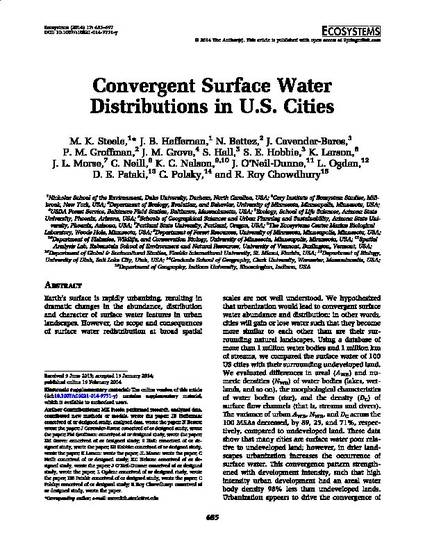
- Water -- Distribution,
- Hydrography,
- Urbanization -- Environmental aspects,
- Cities and towns -- Growth
Earth's surface is rapidly urbanizing, resulting in dramatic changes in the abundance, distribution and character of surface water features in urban landscapes. However,the scope and consequences of surface water redistribution at broad spatialscales are not well understood. We hypothesized that urbanization would lead to convergent surface water abundance and distribution: in other words, cities will gain or lose water such that they become more similar to each other than are their surrounding natural landscapes. Using a database of more than 1 million water bodies and 1 million km of streams, we compared the surface water of 100 US cities with their surrounding undeveloped land. We evaluated differences in areal ( A) and numeric densities ( N) of water bodies (lakes, wetlands, and so on), the morphological characteristics of water bodies (size), and the density ( D) of surface flow channels (that is, streams and rivers). The variance of urban A, N, and D across the 100 MSAs decreased, by 89, 25, and 71%, respectively, compared to undeveloped land. These data show that many cities are surface water poor relative to undeveloped land; however, in drier landscapesurbanization increases the occurrence of surface water. This convergence pattern strengthened with development intensity, such that high intensityurban development had an areal water body density 98% less than undeveloped lands. Urbanization appears to drive the convergence of hydrological features across the US, such that surface water distributions of cities are more similar to each other than to their surrounding landscapes.
Copyright 2014 The Authors.
This work is licensed under a Creative Commons Attribution 4.0 International License.
Originally published by Springer and is available via Springer at: https://doi.org/10.1007/s10021-014-9751-y
